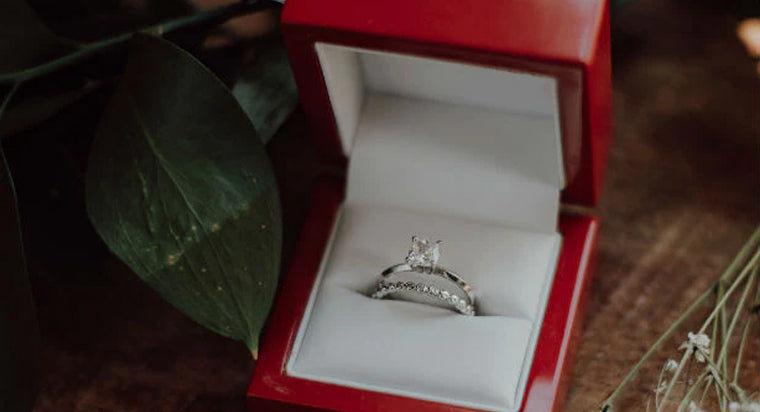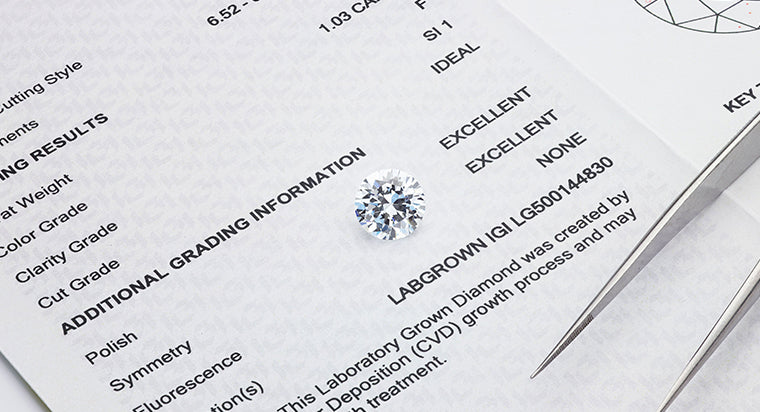What Reduces A Diamonds Worth?

Diamonds are very valuable, but it’s no secret that some are worth more than others. Before we discuss what reduces a loose diamond’s value, it’s important to understand how exactly the value of a diamond is determined in the first place.
TABLE OF CONTENTS
How to determine the value of a diamond
Every single diamond is unique, and each has a different value. They come in many different shapes, sizes, and colors. They each have different internal characteristics.
Rarity is one factor that helps to determine a diamond’s worth. The rarer a diamond is, the more valuable it is. This is because rare diamonds are more appealing than diamonds that lack rarity.
The value of a diamond is not just made up out of thin air - it is carefully determined by jewelry professionals. They use a very systematic way to evaluate specific factors that diamonds have. These diamond professionals use a system that was developed by the GIA (Gemological Institute of America) in the 1950’s, so it has been around for quite a long time.
This system uses four main factors to classify diamonds and determine their value: clarity, cut, color, and carat weight. Otherwise known as the 4Cs. These 4 characteristics determine the value of a finished diamond.
The 4Cs
As mentioned above, the 4Cs are color, clarity, cut, and carat weight. This is how diamond professionals determine a diamond’s value based on each characteristic.
Color
Color - Subtle color differences can have a huge effect on a diamond’s value. The closer that a diamond gets to colorless, the higher value it will have. If a diamond has a light yellow or brownish color, this will automatically reduce its value. In the first paragraph, we mentioned rarity. Diamonds that are colorless are very rare, so they have the highest value.
For more detailed information on the four c’s, visit our education section on carat, clarity, color, and cut.
Clarity
Clarity refers to how many inclusions a diamond has. Diamonds have inclusions, like many other stones from nature. Diamonds can also have blemishes and scratches which can affect clarity. Blemishes and scratches are found on the surface of the diamond, and these are something that lowers value. Inclusions refer to the inside of the diamond. The higher clarity that a diamond has (so the fewer inclusions), the higher value the diamond will have. It’s very rare that you will ever find a completely flawless diamond, but as long as the inclusions can’t be seen by the naked human eye the value will be higher.
Cut
The cut of a diamond refers to the proportions, which will determine how light perform once it enters the diamond. Good proportions make better use of the light, and therefore they are brighter and flashier. There has to be enough contrast between the naturally bright and dark areas of a diamond in order to give the diamond’s pattern a sharp and clean look. A general rule is the higher cut grade a diamond has, the brighter it will be.
Carat weight
Many people know that the higher carat weight a diamond has, the more valuable it is. Larger diamonds with higher carats are much rarer than small diamonds, so again, the rarer a diamond is, the higher the value will be.
Reasons that a diamond’s worth might be reduced
If you are trying to re-sell a diamond, the worth of it is very important in terms of how much you will get for it. Now that you know what factors determine a diamond’s value, here are some things that can lower it’s worth:
- Having scratches on the surface of a diamond, even if they aren’t that noticeable to the human eye.
- Blemishes on the diamond.
- A yellowish, brown, or unclear color of the diamond.
- Many inclusions inside the diamond, especially if they are visible to the naked human eye.
- Small diamond size with a very low carat weight.
- Lack of rarity - a diamond that isn't special and has no remarkable characteristics
Keeping a diamond’s worth
If you are wondering how to keep a diamond valuable, here are some ways that you can prevent and avoid issues that are commonly associated with lower diamond worth.
Handle the diamond sparingly. Diamonds attract grease, and they aren’t the easiest to keep clean. Whenever a diamond is handled, the natural oils from your fingers go onto the diamond’s surface, affecting its brilliance. Try to refrain from touching it as much as possible.
Regularly clean your diamond. One of the best ways to clean your diamonds is to soak them in a gentle solution that’s degreasing. A good example is water with a couple drops of a gentle and mild dish soap. Try to do this once or twice a week. After you take the diamond out of the cleaning solution, use a clean and soft toothbrush (not hard or medium ones) to remove any leftover dirt. You should have a toothbrush set aside that is specially meant for cleaning jewelry such as diamonds.
Be gentle. Always be gentle with handling your diamond, especially when cleaning it. When drying it, use a soft cloth that is free from lint. It might sound like a simple thing, but always make sure to close the drain if you are cleaning it over a sink! It’s crazy how many people forget to do this simple thing.
Don’t expose your diamond to harmful solutions. Make sure that your diamond doesn't come into contact with abrasive household cleaners or bleach. Chemicals such as chlorine can damage some of the metals that are used in diamond settings.
If you follow the above tips, you should be able to keep your diamond’s worth, even after years.







